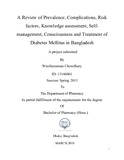| dc.description.abstract | Diabetes is a non-communicable disease which is considered as a universal major health concern
which is related with enhanced rate of mortality and morbidity as well as its care and treatment
impose economic burden on the populations. Therefore, assessing and analyzing the extent of
diabetes related knowledge among the populations, the extent to which they are being treated as
well as controlling their disease condition may reveal new dimensions to decrease the mortality
and morbidity rate associated with diabetes, decline diabetes related complications and
household economic burden. The aim of the review article is to accumulate the existing
information and evidences regarding the prevalence, risk factors, knowledge assessment,
awareness, treatment and self-management scenario of diabetes mellitus in Bangladesh as well as
analyze these conditions in order to guide prevention strategies in the future. Methodology of
this review article was research articles and literature review from various authentic sources of
journals. International Diabetes Federation specifies that the number of diabetic patients in
Bangladesh is 7.1 million which is second largest in South Asian region. A rapid increasing rate
of diabetic patients has been observed in Bangladesh for the previous 2 decades where the
presence of non-insulin dependent diabetes mellitus patients in 1995, 2000 and 2010 were 3.8%,
5.3% and 9.0% respectively. The occurrence of diabetes among the ethnic people is higher in
contrast to the non-ethnic people living in Bangladesh. In general, 16% of the diabetic patients
has good knowledge, sixty six percent has average knowledge and 18% of the patients has poor
basic knowledge regarding diabetes mellitus in Bangladesh. The KAP (knowledge, attitude and
practice) score of diabetes were superior amongst the participants who have diabetes in comparison to the nondiabetic participants. The awareness among patients, treatment receivers
and those who controlled their condition were 41.2%, 36.7% and 14.2% respectively.
Furthermore, people with lack of education, poverty-stricken persons and individuals from
impecunious localities were observed to have lack of diagnosis, knowledge, self-management
and treatment of diabetes in contrast to the educated, high socio-economic status persons.
Contradictorily, number of diabetes sufferer were higher in the urban areas than the rural areas.
Several risk factors of diabetes mellitus includes smoking-59.9%, abdominal obesity-43.3%,
hypertension-14.3%, depression-43% whereas the incidence of routine bodily exercise (only
1.3%) and the habit of consuming seasonal fruits as well as veggie (8.6%) remain significantly
low among the people of Bangladesh. Earlier age onset of diabetes have been observed among the participants in 2005 compared to participants of 1995 along with notable increase in body
mass index indicating that people are getting affected by diabetes mellitus at an early age due to
obesity which is a strong influential factor for the onset of diabetes mellitus. There was
decreased occurrence in the development of diabetes among patients with IGT (impaired glucose
tolerance) who controlled their diet and took regular physical exercise compared to the ones who
didn’t bring any type of lifestyle modifications. Several blood glucose lowering agents used as
remedy for diabetic sufferers in Bangladesh include metformin-46.9%, insulin-40.8%,
sulfonylurea-38.7% and anti-hypertensive drugs-38.7% etc. Several anti-diabetic medicinal
plants for example Coccinia indica, Mamordica Charantia, Trigonella foenum graceum,
Azaradica indica, Ficus racemose and Terminalia chebula etc. are also used for the treatment of
diabetes. Use of information technology by the government of Bangladesh by sending awareness
messages related to diabetes through the cellphones also resulted in positive influence in the
treatment of hyperglycemia. Moreover, launching of new oral hypoglycemic drugs Dapazin
(Dipagliflozin) and launching of new generation insulin ‘Tresiba’ in Bangladesh has opened new
dimensions as these medicines can play significant role to control and cure diabetes. The review
article also picturized a comparative context of prevalence, knowledge assessment, treatment,
self-management and control of diabetes mellitus among Bangladesh and other South Asian or
South-East Asian countries. Although is now regarded as a major worrying matter for the wellbeing
of individuals the treatment as well as control of diabetes mellitus remain significantly low
in Bangladesh. More researches should be conducted by focusing at the root causes,
environmental risk factors (arsenic contaminated water, air pollution) etc. on the occurrence of
diabetes mellitus, pharmacovigilance data and survey of anti-diabetic drugs as well as the
prognosis of diabetes. | en_US |

